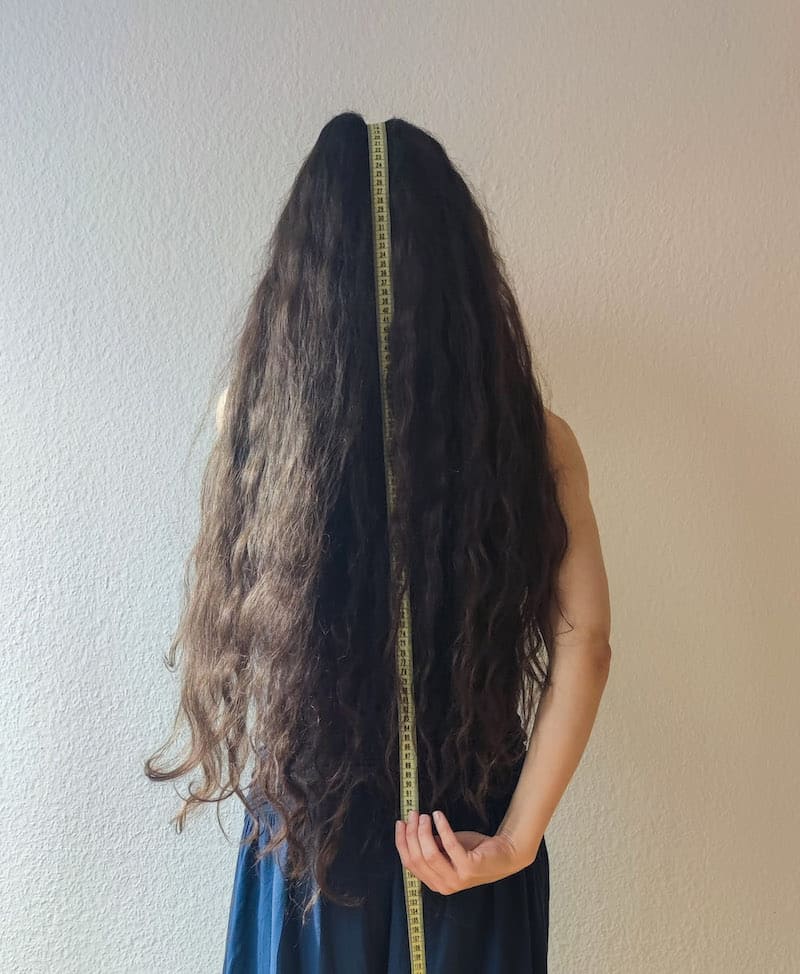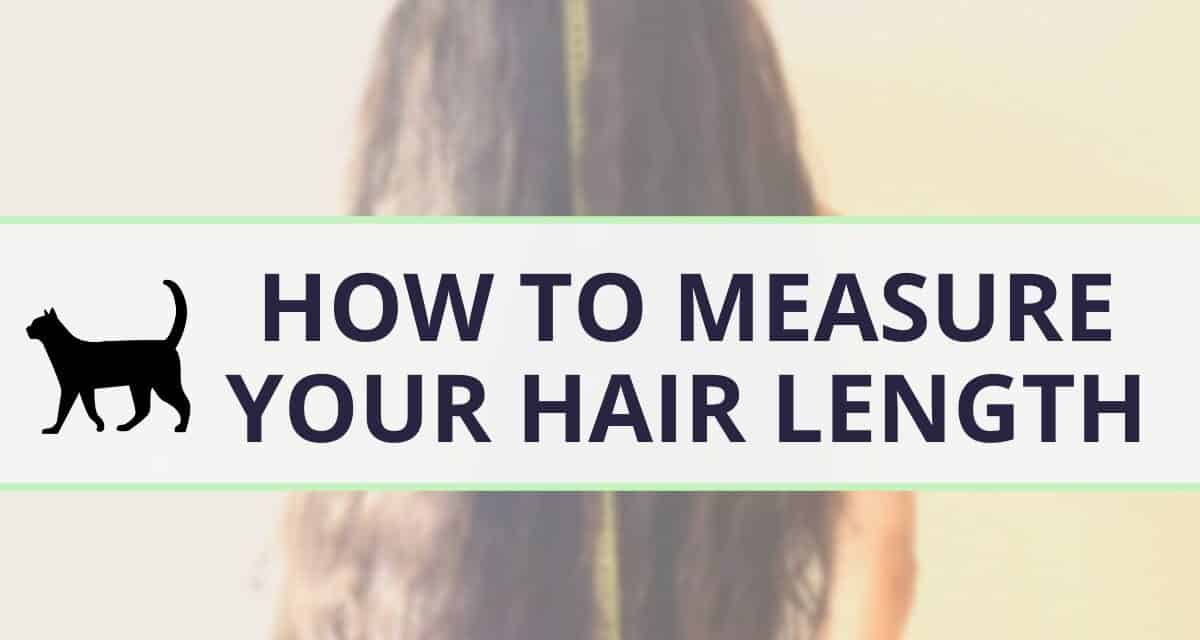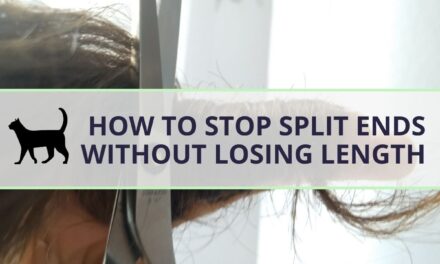If you’re on your way to long hair there will be a time when you’ll want to measure how you’re doing in terms of hair length. There are different reasons for doing that.
You might want to see your progress towards a certain goal length that fits your face shape better. Or you might want to measure your monthly growth to find out if you need to optimise your hair care for faster growth.
Maybe you want to know how much hair length you can donate. Or you’re waiting for having enough hair length to try certain hairstyles for long hair.
Why does it matter? Well, depending on your goals, you might want to use different ways of measuring your hair length.
Related: 5 reasons why your hair is not growing
Disclosure: Some of the links below are so-called provision links, meaning, at no additional cost to you, I can earn a commission if you click through and make a purchase.
Different ways for different hair types
No matter what reason you have for measuring hair length, you want to make sure you get an accurate measurement and you can compare it to previous results.
Unfortunately, this doesn’t work exactly the same way for all hair types.
Curly hair faces a specific challenge here. Shrinkage is a thing! Curly hair is much longer when stretched out compared to its usual curly state.
So you need to decide if you want to measure actual length or visual length. Actual length means you measure your hair stretched out, giving you a more accurate idea of how long your hair is.
And visual length means measuring how long your hair is when curly, meaning the length will fluctuate a little bit depending on curl shrinkage and products used.
Or, if you’re really interested, you could track both to document every aspect of your hair growth journey. Just make sure to note down which state you’re measuring!
Wet or dry?
Additionally, it makes sense to always measure when your hair is wet or always when it’s dry. The reason for this is that hair actually is a little longer when wet, because it soaks up water.
So to make sure you don’t measure different hair lengths due to water absorption, be consistent with whichever decision you take here!
The best way to measure your hair length
The best way to measure your hair length really accurately, independently of hair texture, is using a tape measure. A flexible measuring tape, to be exact. It will give you an exact number, making it easy to compare regular measurements.
Still, your measuring technique matters in order to get good results.
Front hairline to tips technique
A really common way to measure hair length with a tape measure is measuring from the front hairline along the top of your head and down the back of your head all the way to the tips.
Sounds confusing? Have a look at the image below!

This technique doesn’t give you the actual length of a single hair, but instead a measure of your hair “mass”. You can choose yourself if you want to measure the longest single hair tip you can find or the longest hair strands.
In my opinion, the latter makes more sense, as you probably care more about general hair length rather than one single hair.
Depending on how long your hair already is, you might need to have a helper to check the value on the tape. Or you could use the following variation of this technique.
Front hairline to T-Shirt technique
If you don’t have anyone helping you and you can’t manage figuring the hair length out behind your back, you can use a little trick.
Put on an old white T-Shirt first. (Sounds weird, but bear with me!)
Then, instead of letting your hair hang across your back, split it in the middle and take it over your shoulder to the front of your body.
There, combine the two hair parts again and make sure it’s as straight as possible. Now you can make a mark on your T-Shirt where your longest hair ends meet.

And lastly, you can use the tape measure: Put it on the front of the hair line, take it over the top of your head along the line of a middle part and then over your shoulder, just as you did with your hair earlier.
And now you simply measure at the mark you made.

The number should be pretty much the same as with the technique above.
Actual (single) hair length
You might have realised by now that this is not measuring “actual”, real hair length. To do that, you would need to measure exactly from the hair follicles to the tip of a single hair.
And while that is super exact, it’s not really feasible. First of all, you’d need to do that for all hairs, and then calculate some average to even get to a value you can compare.
Or, you could simply measure from the middle part to the end of the hair strand. But as most people have layers, natural or cut in, that value will still vary a lot and make comparisons hard.
Yes, even if you have straight hair!
Measuring hair length by body parts
This hair length chart is probably the best-known way of talking about hair length. In it, we use different body parts to compare different hair lengths.

This is really helpful because everyone can imagine what you mean when you say you have ear length or shoulder-length hair. Even if they’ve never seen the chart above.
It’s probably also the easiest method to gauge your hair length. But, it’s not very accurate either. What exactly is mid-back length, for example? And how is it different from bra strap length?
So this is great to get a general idea of different lengths and categories of hair length, but it’s not very accurate and dependent on your individual body structure.
Length check T-shirts
A similar and increasingly popular way of checking your hair growth progress are hair length check T-shirts.
They work best for medium length hair for quite obvious reasons. Ear length hair, for example, doesn’t even reach the nape of your neck, let alone the first mark on the T-shirt. And really long hair is way past those marks.
But for everyone in between, these can be a really fun and super easy way to track your hair length progress! If your hair length is somewhere around your back, get a length check T-shirt here!*
Ideally, you then combine them with the next hair length check possibility for max motivation!
Comparison shots
Comparison shots are one of the best ways to get motivated throughout a long hair growth journey. Because it does take time and can feel like forever, even if you follow ALL the tips for faster hair growth.
So looking back over a longer period of time and actually seeing the progress you’ve made throughout the months can really help in boosting your motivation to keep at it.
Numbers from measuring are great for comparing facts, and images are great for your spirit!
To make these comparison photos work for you, you need to follow a few rules:
- Stay away from different hairstyles when taking the picture. Different styles mean you can’t see the progress reliably. Basically, just let if flow!
- Note down if you have significant differences in your hair care routine, especially if you have curly or wavy hair. For me, using a CGM hair gel, for example, can make a giant difference in visual hair length! So it’s a good idea to be consistent in products for picture day.
- Take these pictures regularly, yet not too often. Monthly is plenty, but you could also only do it every three months. You don’t want to get discouraged by not seeing a difference in the length of your hair yet. And as hair simply takes time to grow, you need to practice some patience.
Ready to measure your hair?
I hope these tips gave you some guidance on how to measure hair length. In that case, I’d be grateful for any shares. Thank you!

*These links are so-called provision links, meaning, at no additional cost to you, I can earn a commission if you click through and make a purchase.






